人教版七年级英语上册 Starter Units 1-3 复习课件 (共57张PPT)
文档属性
| 名称 | 人教版七年级英语上册 Starter Units 1-3 复习课件 (共57张PPT) | 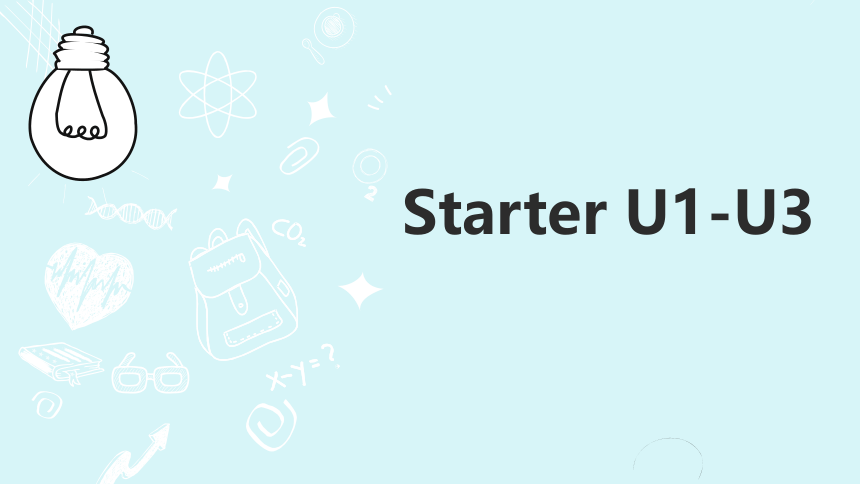 | |
| 格式 | pptx | ||
| 文件大小 | 10.2MB | ||
| 资源类型 | 教案 | ||
| 版本资源 | 人教新目标(Go for it)版 | ||
| 科目 | 英语 | ||
| 更新时间 | 2022-08-15 02:01:03 | ||
图片预览

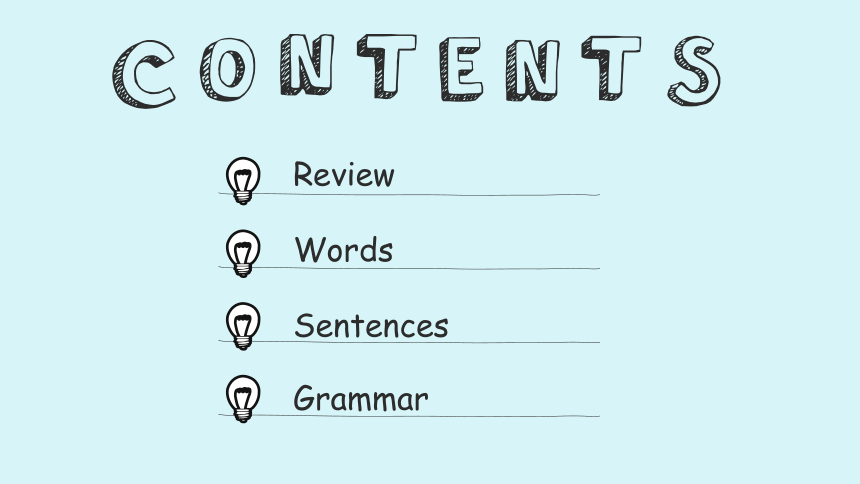

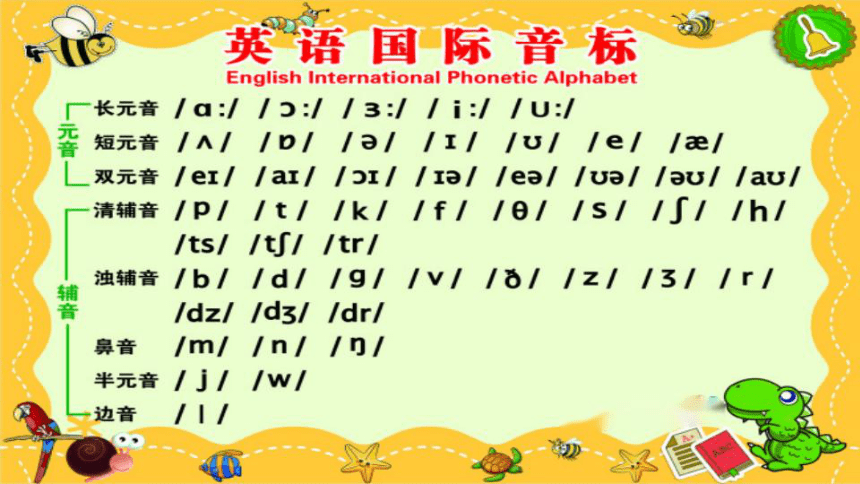
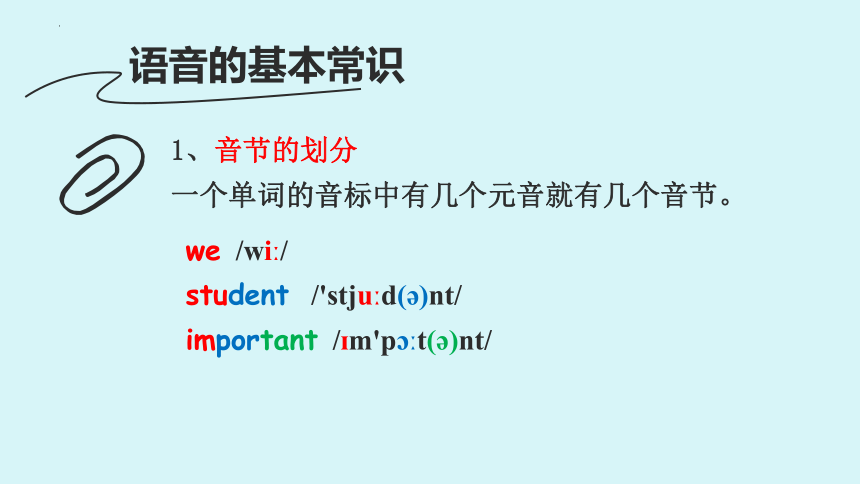
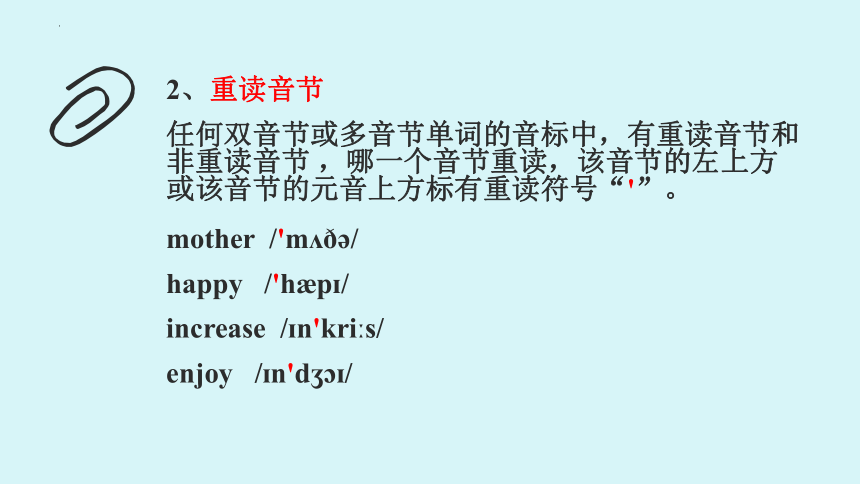

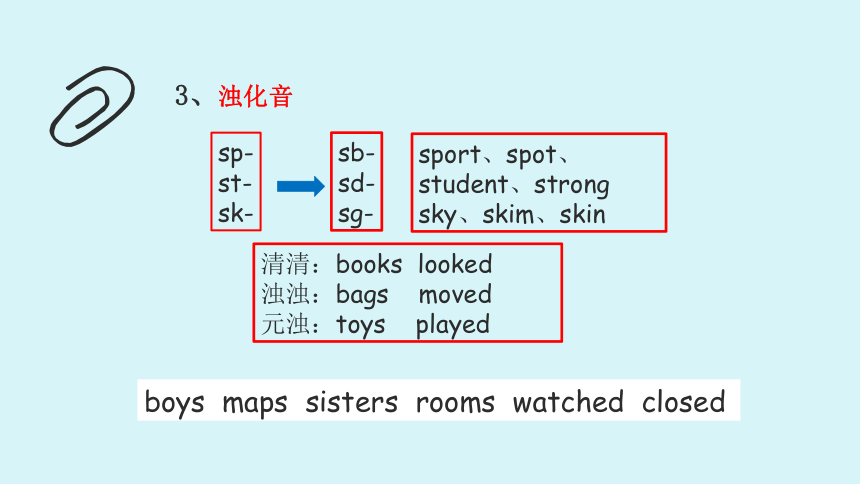
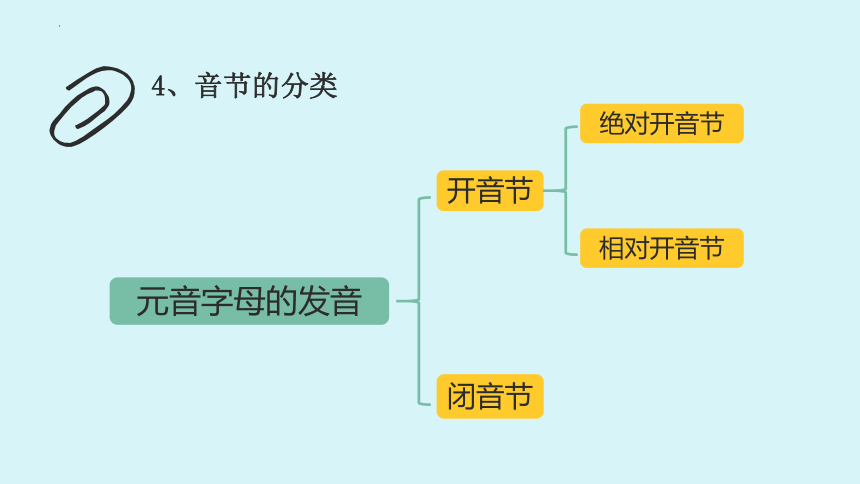
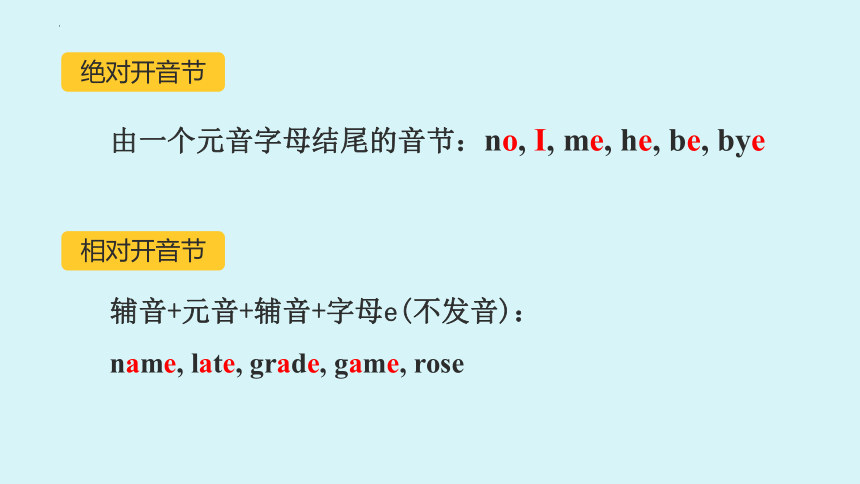
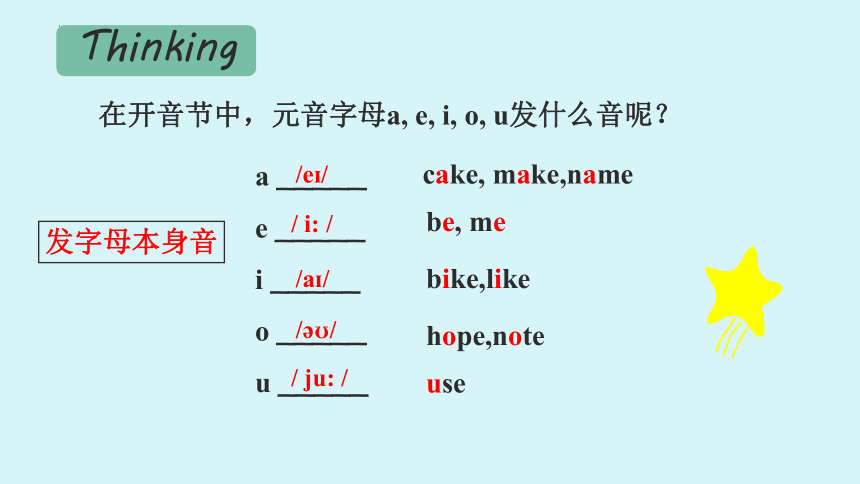
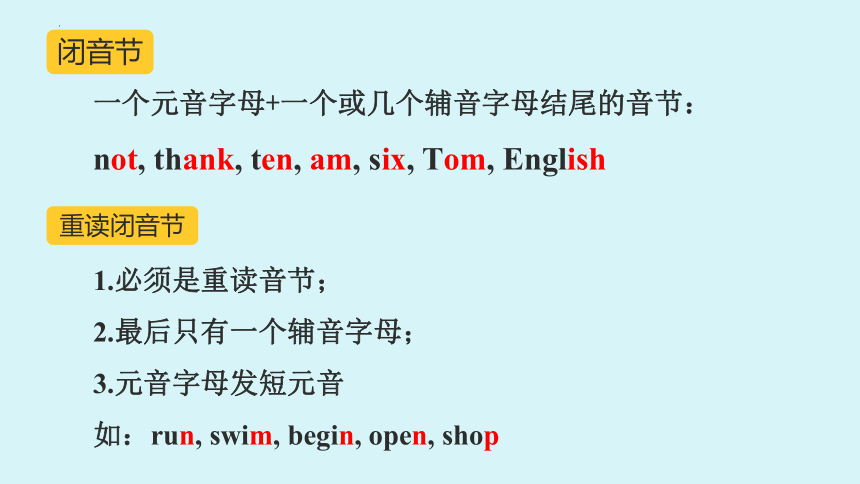
文档简介
(共57张PPT)
Starter U1-U3
Review
Words
Sentences
Grammar
Review
语音的基本常识
1、音节的划分
一个单词的音标中有几个元音就有几个音节。
we /wi /
student /'stju d( )nt/
important / m'p t( )nt/
2、重读音节
任何双音节或多音节单词的音标中,有重读音节和非重读音节 ,哪一个音节重读,该音节的左上方或该音节的元音上方标有重读符号“'”。
mother /'m /
happy /'h p /
increase / n'kri s/
enjoy / n'd /
3、浊化音
以sp__, st___, sk___开头的单词中,清辅音/p/ /t/ /k/分别要发浊辅音/b/ /d/ /g/。
如:sport, stand, study, skim, student等
3、浊化音
sp-
st-
sk-
sb-
sd-
sg-
sport、spot、student、strong
sky、skim、skin
清清:books looked
浊浊:bags moved
元浊:toys played
boys maps sisters rooms watched closed
4、音节的分类
元音字母的发音
开音节
闭音节
绝对开音节
相对开音节
由一个元音字母结尾的音节:no, I, me, he, be, bye
绝对开音节
相对开音节
辅音+元音+辅音+字母e(不发音):name, late, grade, game, rose
在开音节中,元音字母a, e, i, o, u发什么音呢?
Thinking
a _____
e _____
i _____
o _____
u _____
/e /
/ i: /
/a /
/ /
/ ju: /
发字母本身音
cake, make,name
be, me
bike,like
hope,note
use
一个元音字母+一个或几个辅音字母结尾的音节:not, thank, ten, am, six, Tom, English
闭音节
1.必须是重读音节;
2.最后只有一个辅音字母;
3.元音字母发短元音
如:run, swim, begin, open, shop
重读闭音节
A a B b C c D d E e F f G g
[e ] [bi:] [si:] [di:] [i:] [ef] [d i:]
H h I i J j K k L l M m N n
[e t∫] [a ] [d e ] [ke ] [el] [em] [en]
O o P p Q q R r Ss T t U u
[ ] [pi:] [kju:] [ɑ:] [es] [ti:] [ju:]
V v W w X x Y y Z z
[vi:] [′d blju:] [eks] [wa ] [zi:][zed]
Exercises
一、将26个字母按发音分类(写出与所给字母含有相同音素的其他字母)
Aa _______________________________________
Ee ________________________
Ii ________________________
Oo ________________________
Uu ________________________
Ff ________________________
Rr ________________________
Hh Jj Kk
Bb Cc Dd Gg Pp Tt Vv Zz
Yy
Qq Ww
Ll Mm Nn Ss Xx
/ i: /
/ a /
/ a: /
/ e /
/ e /
/ /
/ ju: /
Exercises
写出下列音标对应的单词
/ɡ d/ _______ /m p/_______ /pen/ _______
/fa n/ _______ /k p/ _______ /' k t/ _______
/θ ks/_______ /'ru l (r)/ _______ /wa t/ _______
/ s/_______ /ki / _______ / i / _______
/' ɡl /_______ /ɡri n/ _______ /θri / _______
1
2
3
4
5
Words
颜色
拼写
杯子
橙子
下午
夹克衫
白色
号码;数字
电话机
三
棕色
黄色
紫色
Start
HB _______ CD _______ BBC_______
P_______ NBA____________ kg_____
S_______ M_______ L_______
UFO________ CCTV___________
缩略词
铅笔芯硬黑
光盘
英国广播公司
停车场
(美国)全国篮球协会
千克
小号
中号
大号
不明飞行物
中国中央电视台
其它常见缩略词
英国
联合国
中华人民共和国
胜利
音乐节目主持人
公元前
公元
中国职业篮球联赛
国际求救信号
非典型性肺炎
PRC
UK
UN
V
AD
DJ
BC
VOA
CBA
SOS
SARS
AIDS
WTO
COVID-19
世界贸易组织
美国之声
艾滋病
新冠肺炎
网络聊天常用英语缩略词
Boyfriend 男朋友
Girlfriend 女朋友
By the way 随便说一下
As soon as possible 尽快
See you 再见
Face to face 面对面
laughing out loudly 大声笑
Oh, I see 哦,我知道
Thank you 谢谢
BF
GF
BTW
ASAP
CU
FTF
LOL
OIC
TY
an orange
a jacket
a quilt
a pen
white
a key
a map
What color is it
orange
black
purple
blue/yellow
a ruler
red
green/yellow/pink/blue
colors
pink
yellow
white
black
orange
green
blue
brown
What color is it
red
What color is it
gold
金色
Bronze
铜色
Navy
海军蓝
Rust
铁锈红
Mint
薄荷绿
Silver
银色
Gray
灰色
Ivory
象牙白
a white jacket
一件白色的夹克衫
一把黄色的钥匙
a yellow key
一床蓝色的被子
a blue quilt
一个橙色的橘子
an orange orange
in English
用英语
my teleohone number
我的电话号码
spell it
拼写它
that brown map
这个紫色的杯子
this purple cup
那张棕色的地图
Sentences
1. —What’s this in English 这个用英语怎么说?
—It’s an orange. 它是一个橙子。
2. —What’s that in English 那个用英语怎么说?
—It’s a jacket. 它是一件夹克衫。
3. —What color is it 它是什么颜色的?
—It's red. 它是红色的。
4. Spell it, please. 请拼写一下它。
what引导的特殊疑问句
概念:以特殊疑问词(what,when, where, who, how,why等)开头,并以问号结尾的句子 叫特殊疑问句,答句要根据具体情况来回答,即问什么答什么,不用yes或no回答。
用法:what意为“什么”,可单独使用,后面也可以接一个名词,放在句首。它用于引导特殊疑问句。
1.询问某个东西是什么或某物用英语怎么说
—What’s this in English
—It’s a ruler.
当主语是复数时,be动词要进行相应的变化。
—What are these in English
—They’re books.
What’s =What is
be动词有三种形式,分别为___________、___________、___________。
be动词的用法
am
is
are
数 人称代词 be 缩写形式 例句
第一人称 单数
复数
第二人称 单数
复数
第三人称 单数
复数
I
we
you
you
he
she
it
they
am
is
are
are
are
are
I'm
we're
you're
you're
he's
she's
it's
they're
be动词的用法口诀
我(I)是_________
你(you)是_________ ,
_________适用她(she)他(he)它(it),其余单数用_________,
复数全部都用_________。
am
are
is
is
are
2 .what color用来询问某物品的颜色
—What color is her skirt
—It’s pink.
—What color do you want 你想要什么颜色?
—Blue.
3.what用于询问职业
What’s your father
What does your father do
你爸爸是做什么工作的?
What’s your father’s job
4. what用于询问星期几
—What day is it today 今天是星期几?
—It’s Friday.
5. what用于询问天气情况
—What’s the weather like today 今天天气怎么样?
—It’s cloudy and windy. 多云,有风。
1. — ______ are his shoes
—They’re white.
A. What B. What color
C. What name D. Which color
2. What color ______ the jacket
A. am B. is C. are D. be
B
Exercise
B
3. — ______ your teacher’s phone number
—It’s 465-4123.
A. What color B. What name
C. What time D. What’s
4. — ______ is this in English
—It's a jacket.
A. How B. What
C. When D. Where
D
B
1. This is a map.(就划线部分提问)
2. My bike is black. (就划线部分提问)
3. I’m fine. (就划线部分提问)
4. This is letter U. (就划线部分提问)
5. This is my green ruler.(写同义句)
What’s this
What color is your bike
How are you
What letter is this
My ruler is green..
句型转换
Grammar
不定冠词a/an
(非特指)
定冠词the(特指)
冠词用在名词前面,帮助说明名词所表示的人或物。
冠词a/an/the的用法
不定冠词a/an:通常泛指同类事物中的“任意一个”,用在单数可数名词前
定冠词the:表示特指,指特定的人或事物。
an apple 一个苹果
the apple 那/这个苹果
the apples on the desk
书桌上的那/这些苹果
(泛指任何一个苹果)
(特指一个苹果,the可译为“这个;那个”)
(特指书桌上的那些苹果,the可译为“这 些;那些”)
1.通常泛指同类事物中的“任意一个”,用在单数可数名词前,意为“一个(只,把……)”。
a用在以辅音音素开头的名词前。如:
a key 一把钥匙
不定冠词a/an的用法
an用在以元音音素开头的名词前。如:
an orange 一个橙子
填入冠词a/an
1._____ book 2. _____ eye
3._____hour 4. _____useful idea
5. _____ umbrella 6._____English book
7._____American boy 8. ____HB pencil
9. ____NBA player 10. ____art book
a
an
a
an
an
an
Exercise
an
an
an
an
an
apple, egg, eraser, orange, aunt,
uncle, example, address, actor, hour
English book/party/speech contest
old man, e-mail address
action movie, exciting movie
interesting subject, Art Festival
American boy, alarm clock,
ID card, 8-year-old boy
2.指人或事物的某一种类。如:
I am a boy. 我是一个男孩。
3.指某人或某物,但不具体说明何人或何物。如:
A boy is waiting for you. 一个男孩在等你。
4.表示数量,有“一”的意思,但数的概念没 有one强烈。如:
I have a mouth, a nose and two eyes.
我有一张嘴、一个鼻子和两只眼睛。
5.用在某些固定词组中。如:a lot of 许多
I have a book. The book is on the desk. 我有一本书,这本书在书桌上。
定冠词 the
指特定的人或事物
指上文已提到过的人或事物
世界上独一无二的事物前
序数词、形容词的最高级前
单数可数名词前,表示一类人或物
The map on the desk is mine.
书桌上的那张地图是我的。
the sun 太阳
the first 第一
the pen 钢笔
the poor 穷人
姓氏复数前,表示“一家人”或“夫妇”
the+形容词,表示一类人或事物
play+the+西方乐器名词
play the guitar 弹吉他
the Greens 格林一家人/格林夫妇
定冠词the的用法: 指的不是“任意的”,而是“特定的”
1.单个名词构成的国名、人名等专有名词前不加冠词。如:
This is Tom. 这是汤姆。
名词前不用冠词的情况
2.表示三餐的名词前不加冠词。如:
I have breakfast at 7:00. 我7点吃早餐。
3.play与球类名词搭配时,球类名词前不加冠词。如:
I like playing football. 我喜欢踢足球。
4.在一些固定短语中不用冠词。如:
at night 在晚上 in bed 卧床
5.在星期、月份、季节、节日前不加冠词。如:
on Sunday 在周日
6.复数名词表示一类人或事物时不加冠词。如:
They are teachers. 他们是老师。
7. 可数名词前已有作定语的物主代词(my,your, his,her等)、指示代词(this/these,that/those)、 不定代词(some,any等)及所有格限制时不加冠词。如:
my book 我的书
8. 在表示特定的公园、街道、车站、桥、学校等名词前不加冠词。如:
No.11 Middle School 第十一中学
Exercise
( )1.Tom likes to play ______ violin in the morning and play ______ volleyball in the afternoon.
A.the; the B. the; / C. /; the D. /; /
( )2.There is_________egg on the table, and ____egg is for you.
A. the,an B. an, an C. the ,the D. an, the
( )3.Helen wants to be _______ actor or _______ singer in the future.
A. a; a B. the; the C. a; an D. an; a
B
D
D
( )4.Tim is _____ eleven-year-old boy. He likes playing _____basketball.
A. /; the B. an; / C. an; the D. a;/
( )5. There is _____“h”and _____“w”in the word “how”.
A. a; a B. a; an C. an; a D. an; an
( )6. We can see _____ sun in _____ afternoon.
A. the; the B. a; / C. the; / D. an; /
( )7. —Hey, Li Ming. Do you have _____ basketball
— Yes, it’s over there, behind _____ door.
A. a; a B. the; the C. a; the
B
C
A
C
Ⅱ. 用适当的冠词填空
1. She is _____ English teacher.
2. I eat _____ apple a day.
3. —What’s in _____ box
—There’s _____ red apple and _____ orange in it.
4. There is _____ “n”in the word“nice” .
5. _____ Greens are in China now.
an
an
the
a an
an
The
(1)in 介词,在...里面,在...内
in的用法
in Chinese
in Japanese
There are some notebooks in my schoolbag.
(2)in + 语言, 意为“用...语言”
用汉语 用日语
(3)in + 颜色 表示是穿上了什么颜色的衣服
The girl in red is my sister.
(4)in+大地点(如城市、国家)
in China / in Beijing
He lives in Shanghai.
They will go to Hong Kong in ten days.
in 2016 in January in spring
in the morning in the afternoon
(5)in +一段时间 表示在...以后
(6)in +年/月/季/上午/下午
祈使句可以表示请求、命令等语气。
祈使句
1.结构特点:句子中通常省略主语you;谓语动词一律用原形
2.祈使句的否定:Don't +动词原形
Don't swim in the river.
3.please 意为“请”,表示说话者的客气和礼貌,它可以放在句首或句末(放在句末时,前面一般要加逗号)。
Stand up, please.= Please stand up .
spell V. “拼写;拼读”。它的名词形式是spelling.
祈使句
Spell it, please.
I don’t know the spelling of this word.
How do you spell it
How to spell it
Can you spell it
你如何拼写它?
Thank you
Starter U1-U3
Review
Words
Sentences
Grammar
Review
语音的基本常识
1、音节的划分
一个单词的音标中有几个元音就有几个音节。
we /wi /
student /'stju d( )nt/
important / m'p t( )nt/
2、重读音节
任何双音节或多音节单词的音标中,有重读音节和非重读音节 ,哪一个音节重读,该音节的左上方或该音节的元音上方标有重读符号“'”。
mother /'m /
happy /'h p /
increase / n'kri s/
enjoy / n'd /
3、浊化音
以sp__, st___, sk___开头的单词中,清辅音/p/ /t/ /k/分别要发浊辅音/b/ /d/ /g/。
如:sport, stand, study, skim, student等
3、浊化音
sp-
st-
sk-
sb-
sd-
sg-
sport、spot、student、strong
sky、skim、skin
清清:books looked
浊浊:bags moved
元浊:toys played
boys maps sisters rooms watched closed
4、音节的分类
元音字母的发音
开音节
闭音节
绝对开音节
相对开音节
由一个元音字母结尾的音节:no, I, me, he, be, bye
绝对开音节
相对开音节
辅音+元音+辅音+字母e(不发音):name, late, grade, game, rose
在开音节中,元音字母a, e, i, o, u发什么音呢?
Thinking
a _____
e _____
i _____
o _____
u _____
/e /
/ i: /
/a /
/ /
/ ju: /
发字母本身音
cake, make,name
be, me
bike,like
hope,note
use
一个元音字母+一个或几个辅音字母结尾的音节:not, thank, ten, am, six, Tom, English
闭音节
1.必须是重读音节;
2.最后只有一个辅音字母;
3.元音字母发短元音
如:run, swim, begin, open, shop
重读闭音节
A a B b C c D d E e F f G g
[e ] [bi:] [si:] [di:] [i:] [ef] [d i:]
H h I i J j K k L l M m N n
[e t∫] [a ] [d e ] [ke ] [el] [em] [en]
O o P p Q q R r Ss T t U u
[ ] [pi:] [kju:] [ɑ:] [es] [ti:] [ju:]
V v W w X x Y y Z z
[vi:] [′d blju:] [eks] [wa ] [zi:][zed]
Exercises
一、将26个字母按发音分类(写出与所给字母含有相同音素的其他字母)
Aa _______________________________________
Ee ________________________
Ii ________________________
Oo ________________________
Uu ________________________
Ff ________________________
Rr ________________________
Hh Jj Kk
Bb Cc Dd Gg Pp Tt Vv Zz
Yy
Qq Ww
Ll Mm Nn Ss Xx
/ i: /
/ a /
/ a: /
/ e /
/ e /
/ /
/ ju: /
Exercises
写出下列音标对应的单词
/ɡ d/ _______ /m p/_______ /pen/ _______
/fa n/ _______ /k p/ _______ /' k t/ _______
/θ ks/_______ /'ru l (r)/ _______ /wa t/ _______
/ s/_______ /ki / _______ / i / _______
/' ɡl /_______ /ɡri n/ _______ /θri / _______
1
2
3
4
5
Words
颜色
拼写
杯子
橙子
下午
夹克衫
白色
号码;数字
电话机
三
棕色
黄色
紫色
Start
HB _______ CD _______ BBC_______
P_______ NBA____________ kg_____
S_______ M_______ L_______
UFO________ CCTV___________
缩略词
铅笔芯硬黑
光盘
英国广播公司
停车场
(美国)全国篮球协会
千克
小号
中号
大号
不明飞行物
中国中央电视台
其它常见缩略词
英国
联合国
中华人民共和国
胜利
音乐节目主持人
公元前
公元
中国职业篮球联赛
国际求救信号
非典型性肺炎
PRC
UK
UN
V
AD
DJ
BC
VOA
CBA
SOS
SARS
AIDS
WTO
COVID-19
世界贸易组织
美国之声
艾滋病
新冠肺炎
网络聊天常用英语缩略词
Boyfriend 男朋友
Girlfriend 女朋友
By the way 随便说一下
As soon as possible 尽快
See you 再见
Face to face 面对面
laughing out loudly 大声笑
Oh, I see 哦,我知道
Thank you 谢谢
BF
GF
BTW
ASAP
CU
FTF
LOL
OIC
TY
an orange
a jacket
a quilt
a pen
white
a key
a map
What color is it
orange
black
purple
blue/yellow
a ruler
red
green/yellow/pink/blue
colors
pink
yellow
white
black
orange
green
blue
brown
What color is it
red
What color is it
gold
金色
Bronze
铜色
Navy
海军蓝
Rust
铁锈红
Mint
薄荷绿
Silver
银色
Gray
灰色
Ivory
象牙白
a white jacket
一件白色的夹克衫
一把黄色的钥匙
a yellow key
一床蓝色的被子
a blue quilt
一个橙色的橘子
an orange orange
in English
用英语
my teleohone number
我的电话号码
spell it
拼写它
that brown map
这个紫色的杯子
this purple cup
那张棕色的地图
Sentences
1. —What’s this in English 这个用英语怎么说?
—It’s an orange. 它是一个橙子。
2. —What’s that in English 那个用英语怎么说?
—It’s a jacket. 它是一件夹克衫。
3. —What color is it 它是什么颜色的?
—It's red. 它是红色的。
4. Spell it, please. 请拼写一下它。
what引导的特殊疑问句
概念:以特殊疑问词(what,when, where, who, how,why等)开头,并以问号结尾的句子 叫特殊疑问句,答句要根据具体情况来回答,即问什么答什么,不用yes或no回答。
用法:what意为“什么”,可单独使用,后面也可以接一个名词,放在句首。它用于引导特殊疑问句。
1.询问某个东西是什么或某物用英语怎么说
—What’s this in English
—It’s a ruler.
当主语是复数时,be动词要进行相应的变化。
—What are these in English
—They’re books.
What’s =What is
be动词有三种形式,分别为___________、___________、___________。
be动词的用法
am
is
are
数 人称代词 be 缩写形式 例句
第一人称 单数
复数
第二人称 单数
复数
第三人称 单数
复数
I
we
you
you
he
she
it
they
am
is
are
are
are
are
I'm
we're
you're
you're
he's
she's
it's
they're
be动词的用法口诀
我(I)是_________
你(you)是_________ ,
_________适用她(she)他(he)它(it),其余单数用_________,
复数全部都用_________。
am
are
is
is
are
2 .what color用来询问某物品的颜色
—What color is her skirt
—It’s pink.
—What color do you want 你想要什么颜色?
—Blue.
3.what用于询问职业
What’s your father
What does your father do
你爸爸是做什么工作的?
What’s your father’s job
4. what用于询问星期几
—What day is it today 今天是星期几?
—It’s Friday.
5. what用于询问天气情况
—What’s the weather like today 今天天气怎么样?
—It’s cloudy and windy. 多云,有风。
1. — ______ are his shoes
—They’re white.
A. What B. What color
C. What name D. Which color
2. What color ______ the jacket
A. am B. is C. are D. be
B
Exercise
B
3. — ______ your teacher’s phone number
—It’s 465-4123.
A. What color B. What name
C. What time D. What’s
4. — ______ is this in English
—It's a jacket.
A. How B. What
C. When D. Where
D
B
1. This is a map.(就划线部分提问)
2. My bike is black. (就划线部分提问)
3. I’m fine. (就划线部分提问)
4. This is letter U. (就划线部分提问)
5. This is my green ruler.(写同义句)
What’s this
What color is your bike
How are you
What letter is this
My ruler is green..
句型转换
Grammar
不定冠词a/an
(非特指)
定冠词the(特指)
冠词用在名词前面,帮助说明名词所表示的人或物。
冠词a/an/the的用法
不定冠词a/an:通常泛指同类事物中的“任意一个”,用在单数可数名词前
定冠词the:表示特指,指特定的人或事物。
an apple 一个苹果
the apple 那/这个苹果
the apples on the desk
书桌上的那/这些苹果
(泛指任何一个苹果)
(特指一个苹果,the可译为“这个;那个”)
(特指书桌上的那些苹果,the可译为“这 些;那些”)
1.通常泛指同类事物中的“任意一个”,用在单数可数名词前,意为“一个(只,把……)”。
a用在以辅音音素开头的名词前。如:
a key 一把钥匙
不定冠词a/an的用法
an用在以元音音素开头的名词前。如:
an orange 一个橙子
填入冠词a/an
1._____ book 2. _____ eye
3._____hour 4. _____useful idea
5. _____ umbrella 6._____English book
7._____American boy 8. ____HB pencil
9. ____NBA player 10. ____art book
a
an
a
an
an
an
Exercise
an
an
an
an
an
apple, egg, eraser, orange, aunt,
uncle, example, address, actor, hour
English book/party/speech contest
old man, e-mail address
action movie, exciting movie
interesting subject, Art Festival
American boy, alarm clock,
ID card, 8-year-old boy
2.指人或事物的某一种类。如:
I am a boy. 我是一个男孩。
3.指某人或某物,但不具体说明何人或何物。如:
A boy is waiting for you. 一个男孩在等你。
4.表示数量,有“一”的意思,但数的概念没 有one强烈。如:
I have a mouth, a nose and two eyes.
我有一张嘴、一个鼻子和两只眼睛。
5.用在某些固定词组中。如:a lot of 许多
I have a book. The book is on the desk. 我有一本书,这本书在书桌上。
定冠词 the
指特定的人或事物
指上文已提到过的人或事物
世界上独一无二的事物前
序数词、形容词的最高级前
单数可数名词前,表示一类人或物
The map on the desk is mine.
书桌上的那张地图是我的。
the sun 太阳
the first 第一
the pen 钢笔
the poor 穷人
姓氏复数前,表示“一家人”或“夫妇”
the+形容词,表示一类人或事物
play+the+西方乐器名词
play the guitar 弹吉他
the Greens 格林一家人/格林夫妇
定冠词the的用法: 指的不是“任意的”,而是“特定的”
1.单个名词构成的国名、人名等专有名词前不加冠词。如:
This is Tom. 这是汤姆。
名词前不用冠词的情况
2.表示三餐的名词前不加冠词。如:
I have breakfast at 7:00. 我7点吃早餐。
3.play与球类名词搭配时,球类名词前不加冠词。如:
I like playing football. 我喜欢踢足球。
4.在一些固定短语中不用冠词。如:
at night 在晚上 in bed 卧床
5.在星期、月份、季节、节日前不加冠词。如:
on Sunday 在周日
6.复数名词表示一类人或事物时不加冠词。如:
They are teachers. 他们是老师。
7. 可数名词前已有作定语的物主代词(my,your, his,her等)、指示代词(this/these,that/those)、 不定代词(some,any等)及所有格限制时不加冠词。如:
my book 我的书
8. 在表示特定的公园、街道、车站、桥、学校等名词前不加冠词。如:
No.11 Middle School 第十一中学
Exercise
( )1.Tom likes to play ______ violin in the morning and play ______ volleyball in the afternoon.
A.the; the B. the; / C. /; the D. /; /
( )2.There is_________egg on the table, and ____egg is for you.
A. the,an B. an, an C. the ,the D. an, the
( )3.Helen wants to be _______ actor or _______ singer in the future.
A. a; a B. the; the C. a; an D. an; a
B
D
D
( )4.Tim is _____ eleven-year-old boy. He likes playing _____basketball.
A. /; the B. an; / C. an; the D. a;/
( )5. There is _____“h”and _____“w”in the word “how”.
A. a; a B. a; an C. an; a D. an; an
( )6. We can see _____ sun in _____ afternoon.
A. the; the B. a; / C. the; / D. an; /
( )7. —Hey, Li Ming. Do you have _____ basketball
— Yes, it’s over there, behind _____ door.
A. a; a B. the; the C. a; the
B
C
A
C
Ⅱ. 用适当的冠词填空
1. She is _____ English teacher.
2. I eat _____ apple a day.
3. —What’s in _____ box
—There’s _____ red apple and _____ orange in it.
4. There is _____ “n”in the word“nice” .
5. _____ Greens are in China now.
an
an
the
a an
an
The
(1)in 介词,在...里面,在...内
in的用法
in Chinese
in Japanese
There are some notebooks in my schoolbag.
(2)in + 语言, 意为“用...语言”
用汉语 用日语
(3)in + 颜色 表示是穿上了什么颜色的衣服
The girl in red is my sister.
(4)in+大地点(如城市、国家)
in China / in Beijing
He lives in Shanghai.
They will go to Hong Kong in ten days.
in 2016 in January in spring
in the morning in the afternoon
(5)in +一段时间 表示在...以后
(6)in +年/月/季/上午/下午
祈使句可以表示请求、命令等语气。
祈使句
1.结构特点:句子中通常省略主语you;谓语动词一律用原形
2.祈使句的否定:Don't +动词原形
Don't swim in the river.
3.please 意为“请”,表示说话者的客气和礼貌,它可以放在句首或句末(放在句末时,前面一般要加逗号)。
Stand up, please.= Please stand up .
spell V. “拼写;拼读”。它的名词形式是spelling.
祈使句
Spell it, please.
I don’t know the spelling of this word.
How do you spell it
How to spell it
Can you spell it
你如何拼写它?
Thank you
同课章节目录
- starters 预备篇(2012秋审查)
- Unit 1 Good morning !
- Unit 2 What’s this in English?
- Unit 3 What color is it ?
- Unit 1 My name's Gina.
- Section A
- Section B
- Unit 2 This is my sister.
- Section A
- Section B
- Unit 3 Is this your pencil?
- Section A
- Section B
- Unit 4 Where's my schoolbag?
- Section A
- Section B
- Unit 5 Do you have a soccer ball?
- Section A
- Section B
- Unit 6 Do you like bananas?
- Section A
- Section B
- Unit 7 How much are these socks?
- Section A
- Section B
- Unit 8 When is your birthday?
- Section A
- Section B
- Unit 9 My favorite subject is science.
- Section A
- Section B
